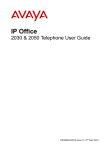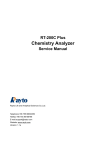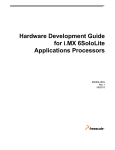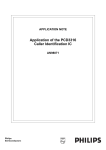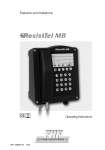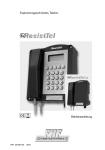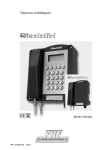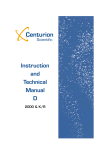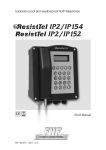Download Telephone for Hazardous Locations Operating instructions
Transcript
Telephone for Hazardous Locations Operating instructions FHF BA 9703-01 03/15 Foreword Our telephone ExResistTel/ExResistTel ZB is a captivating product on account of its precision, convenience, long service life and reliability. It is freely programmable and the optimum choice for adverse ambient conditions. Be it seawater, high atmospheric humidity, dust or the toughest mechanical strains, the weather-resistant telephone accomplishes its aim in any conditions. The reason for this is the robust keypad made of V4A steel and an extremely solid housing made of impact-resistant and shockproof cast-moulding material. All of the components utilised are even resistant to leeches and lubricants. The 21-button V4A-steel keypad - which can be operated by a user wearing gloves - and the easily readable alphanumeric display as well as the uncomplicated menus all ensure simple operation - thus fulfilling the requirements for a leadingedge and operationally reliable means of communication. As a telephone suitable for connecting to the public telephone network and to private automatic branch exchanges, the ExResistTel always ensures reliable connections. ExResistTel ZB is designed for telephone exchange operation and corresponds to the ExResistTel, except for keypad and display. Note Please read the operating manual carefully before installing the device. Please check the contents of the box for completeness. This equipment is suitable for use in Class I, Division 2, Groups A, B, C, D or non-hazardous locations only. Cet appareil est qualifié à être utilize en locaux classes Class I, Division 2, Groups A, B, C, D ou seulement dans les emplacements non-dangereux. W A R N I N G – Do not disconnect equipment unless power has been switched off or the area is known to be non-hazardous. AVERTISSEMENT – Déconnectez pas l´appareil avant que l´alimentation est mise hors tension ou l´emplacement est considéré à être non-dangereux. W A R N I N G – Explosion hazard – Substitution of any component may impair suitability for Class I, Division 2. AVERTISSEMENT – Risque d´explosion – Remplacement d´aucun composant peut affaiblir aptitude pour Class I, Division 2. 2 Table of contents General operating instructions ................................................................ 5 Customer information.............................................................................. 5 Device ..................................................................................................... 7 Device – construction .......................................................................... 7 Variant ExResistTel ZB notes .......................................................... 7 Device – drawings of the housing ....................................................... 8 Device - connection diagram ............................................................. 11 Device – display and keypad............................................................. 12 Display icons.................................................................................. 12 Key functions ................................................................................. 13 Device – mounting and installation.................................................... 14 Device – adjusting sling holder.......................................................... 15 Device – start-up ............................................................................... 15 Device – maintenance ....................................................................... 15 As delivered condition – box contents .................................................. 15 As delivered condition – default settings............................................... 16 Operation .............................................................................................. 17 Operation – conversation modes ...................................................... 17 Handset conversation mode .......................................................... 17 Open listening conversation mode ................................................ 17 Handsfree conversation mode ....................................................... 17 Headset conversation mode .......................................................... 17 Operation – answering calls .............................................................. 18 Operation – making calls ................................................................... 18 Operation – when the phone is locked .............................................. 19 Configuration......................................................................................... 19 Configuration - Main Menu (Overview).............................................. 20 Configuration - Phone Book .............................................................. 21 Configuration - Ringer ....................................................................... 21 Configuration - Volume...................................................................... 21 Configuration - Dialing Mode ............................................................. 22 Configuration - PBX\PSTN ................................................................ 22 Calls to the PSTN .......................................................................... 22 Inquiries ......................................................................................... 22 Configuration - F-Relay ..................................................................... 23 Configuration - Menu ......................................................................... 23 Configuration - Fact. Settings ............................................................ 23 Configuration - PIN ............................................................................ 24 Configuration - Phone Lock ............................................................... 24 Configuration - Menu Lock ................................................................ 25 Configuration - Version...................................................................... 25 3 Menu ..................................................................................................... 26 Menu – used confirmation-, error- and advisory tones ...................... 26 Menu – using menus ......................................................................... 26 Menu – using sliders.......................................................................... 27 Menu – using options ........................................................................ 27 Menu – using input lines.................................................................... 28 Menu – using phone book ................................................................. 29 Technical Data ...................................................................................... 31 Service .................................................................................................. 33 Service – maintenance ...................................................................... 33 Service – waste disposal ................................................................... 33 Service – warning and safety instructions ......................................... 34 Identification .......................................................................................... 35 4 General operating instructions 1. Both the ExResistTel telephone and the ZB version are designed for connection to dial ports with analogue connection points. 2. The handset is fitted with a stray-field coil for connecting hearingaids. People who use hearing-aids which have an inductive receiver can receive the earphone signal directly. 3. The ZB version is not equipped with keypad and display, therefore not all the features are available with this version. 4. The ExResistTel has a handset module with a dry reed contact as a hook switch. In order to terminate an existing call connection, the handset must be hung up. In order to interrupt an existing call connection, it is sufficient to press the disconnect key on the keypad.(see page 12) 5. Use the menu to program the appropriate settings. To access the menu, pick up the handset and press the "YES" key. 6. If you take longer than 2 minutes before you begin making a choice, the power supply of the exchange may be switched off. If that occurs, you will no longer hear a dialling tone. In that case, please replace the handset and wait 2 seconds before picking it up again. 7. When a setting is stored successfully, this is confirmed by an acknowledgement tone. 8. When you receive a call, the ExResistTel rings at the ringer-volume level selected by you and, for the duration of the calling sound, the symbols ( ( ( ) ) ) appears on the display. 9. If you enter a PIN with the menu you can restrict or block settings and dial functions. Forgetting the PIN is the equivalent of losing a key. If you forget the PIN, please contact our technical support. Customer information This device has been tested and found to comply with the limits for a class B digital device, pursuant to part 15 of the FCC rules. This device complies with part 68 of the FCC rules and with the standard TIA 968B. The REN (Ringer Equivalence Number) is used to determine the number of devices that may be connected to a telephone line. Excessive RENs on a telephone line may result in the devices not ringing in response to an incoming call. In most but not all areas, the sum of RENs should not exceed five (5.0). To be certain of the number of devices that may be connected to a line, as determined by the total REN, contact the local telephone company. The REN is part of the product identifier and has the format REN n.n.B. The letter B denotes the ringer type. If this telephone causes harm to the telephone network, the telephone company will notify you in advance that temporary discontinuance of 5 service may be required. But if advance notice isn´t practical, the telephone company will notify the customer as soon as possible. Also, you will be advised of your right to file a complaint with the FCC if you believe it is necessary. The telephone company may make changes in its facilities, equipment, operations or procedures that could affect the operation of the device. If it happens, the telephone company will provide advance notice in order for you to make necessary modifications to maintain uninterrupted service. If trouble is experienced with this telephone, for repair or warranty operation, please contact your supplier. If the device is causing harm to the telephone network, the telephone company may request that you disconnect the device until the problem is resolved. If you have specially wired alarm equipment connected to the telephone line, ensure the installation of this telephone does not disable your alarm equipment. If you have questions about what will disable alarm equipment, consult your telephone company or a qualified installer. This telephone must not be used on party lines. This telephone is of a type that is not intended to be repaired. This telephone is hearing aid compatible (HAC). 6 Device Device – construction The two-part housing of ExResistTel consists of an electrostatically conducting compressed material into the top portion of which a stainless steel front plate is inserted. A cut-out closed with a sight glass in the front plate, is arranged over the display of the telephone. A trough for incorporating cast electronic modules, as well as a connection compartment into which up to four leads can be introduced, is built into the box shaped lower part. The upper part with keypad and display section is compressed onto the lower part along with an intermediate circumventing gasket with the help of four screws and seals off the internal space. Variant ExResistTel ZB notes ------------------------------------------------------ExResistTel ZB is a variant of the telephone that has neither a display nor a keypad and can be used in centralised operation applications (ZB). Differing from the identical handling of incoming calls, the ZB variant is passive during outgoing calls. The private branch exchange used is responsible for dialling or establishing a voice connection, which should be configured accordingly if required. Apart from the display and keypad, the variant ExResistTel ZB has the technical data of the standard variant ExResistTel at delivery. All keys, display and setting dependent statements in the operating manual do not necessarily apply to the ZB variant. The operation with a headset is also not possible. For a better overview, the use of an explicit identification such as "not applicable for the ZB variant" of all affected passages has been avoided. 7 Device – drawings of the housing UPPER PART OF THE TELEPHONE Figure 1 Set view. Device version ExResistTel ZB is not equipped with keypad and display. The front plate of this version is a closed stainless steel plate. 8 LOWER PART OF THE TELEPHONE Figure 2 Outside view of telephone lower part. Note: Pos. 17, 18 and 19 are only used when the headset is connected. 9 UPPER PART OF THE TELEPHONE Figure 3 Inside view of telephone upper part. Note: The ZB version is not equipped with a pin contact strip. 10 LOWER PART OF THE TELEPHONE Figure 4 Inside view of telephone lower part and mounting holes For making a drilling template please see dimensions. Device – connection diagram Follow the instructions on page 23 of this manual for configuring the used relay. Figure 6 Connection diagram 11 Device – display and keypad Display icons ----------------------------------------------------------------------------Symbol Meaning Key is active: dials the last dialled telephone number (call redial). not used Tone dialling is set. 1 Key is active: Opening of the menu "unlock” ↔ menu navigation 1 Key is active: Temporary reduction (-) of the volume ↔ menu navigation 1 Key is active: not used ↔ delete character 1 Key is active: Temporary increase (+) of the volume ↔ menu navigation 1 Key is active: Opening of the "main menu" ↔ menu navigation Impulse dialling is set. The conversation takes place in the mode: Headset. The conversation takes place with the loudspeker on in the mode Open Listening or Handsfree. 1 Key function changes depending on state. Statements describe the key function in the basic state or with open menu. (Key x is active: basic state ↔ menus). 12 Key functions ---------------------------------------------------------------------------Temporary volume setting and menu control S 12, Display icons Manual dialling or entry of numbers and text. S 18, Operation – making calls S 28, Menu – using input lines 1 Control of the conversation-mode. S 17, Operation – conversation modes Disconnecting a connection with handset lifted. Redialling the last dialled telephone number. S 18, Operation – making calls 2 Introducing a query. S 18, Operation – answering calls S 18, Operation – making calls 1 For text entry, the key enables switching between upper case- [ABC] and lower case [abc]. S 28, Menu – using input lines 2 For telephone number entry, the key enables the entry of special dialling characters (R, A, B, C, D, - & T). S 28, Menu – using input lines Notes: Automatic key repetition of the telephone is active on opening of menu functions. After an initial delay of 500 ms, key events are repeated at an interval of 125 ms as long as the key is pressed. This way, the browsing of the telephone directory, the adjusting of sliding controllers, the shifting of cursor positions etc. is simplified. 13 Device – mounting and installation a) The device may only be installed on an even surface and in a vertical position. Provide the selected area of installation with suitable holes for fastening the device. The diameter of the drilled hole is dependent on the screw employed (screw diameter max. 5/16” [8 mm]) and the type of supporting base material (steel, wood, concrete, plasterboard etc.) and must be chosen accordingly. S 11, Figure 4 Inside view of telephone lower part .. b) Loosen (2) cover screws, pull out plug connectors (7) Figure 4, of the flat cable from the pin contact strip (21) Figure 3, of the upper part of the telephone (1) and take off the upper part. S 8, Figure 1 Set view In case headset accessory is used. c) Screw on the (17) handle from the accessory packing with the help of the two supplied screws (18) onto the rear side of the telephone (3). S 9, Figure 2 Outside view of telephone lower part d) Remove sealing plugs (6) from the lower part of the telephone (3) and screw in cable entry gland M20x1.5 (19) Figure 2, from the accessory packing. S 11, Figure 4 Inside view of telephone lower part and mounting holes e) Insert screws with head diameters of 0.3937 in [10 mm] to 0.51181 in [13 mm] in the openings (20) of the lower part of the telephone (3) secure the lower part of the telephone (3) onto the prepared installation surface. S 11, Figure 4 Inside view of telephone lower part and mounting holes In case headset accessory is used. f) Pass the prefabricated connecting cables from the accessory packing through the cable entry gland M20x1.5 (19) and fix them with the help of the screw fasteners. S 9, Figure 2 Outside view of telephone lower part g) Place the cable core ends of the connecting cables on the terminals located in the section HEADSET of the connecting diagram. The terminals are labelled with the cable core colours of the connecting cables. S 11, Figure 6 Connection diagram h) Pass and fix the connecting cables of the telephone through the cable entry glands (5). S 11, Figure 4 Inside view of telephone lower part and mounting holes 14 i) Place the tip/ring cable core ends of the connecting cables on the terminals located in the section TELEPHONE NETWORK LINES of the connecting diagram and marked as TIP or RING. S 11, Figure 6 Connection diagram In case relay contacts are used j) Pass and fix the switching contact connecting cables through the cable entry glands (4). S 11, Figure 4 Inside view of telephone lower part and mounting holes k) Place the cable core ends of the switching contact connecting cables on the RELAY of the connecting diagram. In the case of a DC-load, terminals labelled as DC or DC+ must be used; in case of AC switching load, the two terminals labelled AC ~ must be used. S 11, Figure 6 Connection diagram l) Check for proper sealing before placing the upper part of the telephone. m) Insert the plug connectors (7) of the flat cable into the pin contact strip (21) of the telephone upper part (1) and place the upper part on the telephone lower part (3). n) Fix the telephone upper part (1) with the four cover screws (2). Device – adjusting sling holder The holding strength for the handset is continuously adjustable. Loosen the screws (15) and move the stopping catches (16). Pushing the stopping catches together increases the holding strength whereas pulling them apart reduces it. Tighten the screws again. Device – start-up The ExResistTel telephone is ready for operation as soon as it has been connected to the telephone network. Device – maintenance The ExResistTel telephone contains no parts that have to be maintained. As delivered condition – box contents The scope of delivery includes: - ExResistTel telephone - this operating manual - 2 self-adhesive lettering 15 As delivered condition – default settings To enable you to use the telephone immediately after connecting it, we have made default settings for general utilisation purposes. Using the menu, you can alter these default values in accordance with your own personal necessities and connection requirements. Upon delivery of the telephone, the following default values are set: • Phone book empty • Ringer volume 6 • Ringer melody 0 • Handset volume 1 • Headset volume 2 • Open listening volume 5 • Handsfree volume 5 • Dialing mode Dual Tone Multi Frequency (DTMF) signal duration 90 ms • Exchange code empty • Pause after exchange code 1 second • F-Relay both relays AC/DC are steadily off • Menu language English • Welcome text none • LCD contrast 5 • PIN 0000 • Telephone lock off • Direct call number empty • Menu lock off • Last number redial empty • Recall key function flash duration 120 ms Using the programming menu, you may reset the settings to their defaults at any time. 16 Operation Operation – conversation modes Types of conversation-operations for telephone calls that are available to you are listed below. To set and change the selected types of operation, the handset and speaker key Figure 7 must be operated as shown. Figure 7 Conversation modes of the ExResistTel. Handset conversation mode The conversation must be conducted over the microphone and earpiece of the lifted handset; the speaker is switched off. Open listening conversation mode The conversation must be conducted over the microphone and earpiece of the lifted handset. Persons present can listen in to the conversation over the switched-on speaker. Handsfree conversation mode The conversation must be conducted over the microphone that is located below the keypad and the switched-on speaker. Persons present can listen in to the conversation and participate actively in it. Headset conversation mode The conversation must be conducted over the microphone and earpiece of the connected headset; the speaker is switched off. 17 Operation – answering calls The telephone signals an incoming call. Lift the handset or press the speaker key to accept the call in the conversation-operation type preferred by you. The greeting message appears in the display and the connection to the calling party is established. -------Conversation-----Temporarily lower the volume for the duration of the call. Temporarily raise the volume for the duration of the call. Make a query. Operation – making calls Lift the handset or press the speaker key to make the call in the conversation-operation type preferred by you. The greeting message appears in the display and you will hear the dial tone (dial ready tone) of the public telephone network or of the private branch exchange. Dial the telephone number of the dialogue partner. -----------Dialling---------.. Manual entry and simultaneous dialling of the telephone number. Dialling the last dialled telephone number. x2 set telephone number in telephone directory manually | - or by entry of a search word and trigger dialling procedure with 1-2 key operations. S 29, Menu – using phone book -------Conversation-----Temporarily lower the volume for the duration of the call. Temporarily raise the volume for the duration of the call. Make a query. 18 Operation – when the phone is locked In the case of active telephone lock, dialling is restricted or completely blocked. The lock, which is active, will be shown as follows in the second line of the display on shifting to the selected conversation-operation. Phone Book Only those telephone numbers listed in the telephone directory can be dialled. For this, the telephone directory must be opened by key activation , the chosen telephone number set manually | - or by entering a search word and triggering the dialling by activating a key . S 29, Menu – using phone book Direct Call Only the numbers listed in the MainMenu\ PhoneLock\DirectCallNo can be dialled. For this, any key except the keys and can be pressed to trigger the dialling. Total Lock Dialling is completely blocked. ------ Conversation -----Opens the "Unlock" menu with which the telephone lock can be deactivated. Temporarily lower the volume for the duration of the call. Temporarily raise the volume for the duration of the call. -----Unlock----- Menu "Unlock" > for good Deactivates the telephone lock permanently. this once Deactivates the telephone lock for the duration of the current connection. ======End======= Configuration The ExResistTel is provided with a menu with which the different properties of the telephone have to be adapted to the prevailing operating conditions. This menu marked "Menu Main" is to be opened pressing the key . Adjustable properties, their factory settings and adjustment ranges are explained in detail below. Explanations such as those required for setting of required menu elements, can be found in S 26 Menu. 19 Configuration - Main Menu (Overview) 20 Configuration - Phone Book With menu element Phone Book, the telephone directory application that takes care of 50 subscriber entries, can be opened. The name and telephone number of each entry can be a maximum of 16 or 32 characters long. S 29, Menu – using phone book Ex-factory, the telephone directory is completely empty. Factory setting: Name ................................. 50 x "":16 Calling Number............ 50 x "":32 // blank // blank Configuration - Ringer With the slide controls, Volume and Melody volume and melody of the acoustic call signal can be set. Notes: Volume setting 0 activates the switching off or muting of the acoustic call signalling. Factory setting: Melody ................................................0 Volume ................................................6 // volume optimized, intermittent tone // maximum volume Configuration - Volume The initial volumes for conversation-operations of the same name must be set with the four slide controllers. During a telephone-meeting, the set volumes can be temporarily changed with the keys and . Factory setting: Handset ..............................................1 Headset ..............................................2 Open Listening...............................5 Handsfree..........................................5 // standard setting // standard setting // standard setting // standard setting 21 Configuration - Dialing Mode The selected dialling mode must be set with the option switch Dialing Mode; the following procedures are available. Dtmf unlim tone dialling procedure with continuous tone duration. The procedure works only for manual dialling modes and causes the signal tone to be on as long as the corresponding key is pressed, however at least for 90 ms. The intermediate signal pause duration is fixed for 90 ms. All automatic dialling procedures are carried out with the setting "Dtmf 90 ms". Dtmf 90 ms tone dialling procedures to be set with the following time settings. T_dtmf_std_dd 90 ms // signal duration T_dtmf_std_idp 90 ms // intermediate signal-pause duration Pulse 1.5:1 pulse dialling procedures to be set with the following time settings. T_pulse_bapt_db 60 ms // signal-break-duration T_pulse_bapt_db 40 ms // signal-make-duration T_pulse_bapt_idp 800 ms // intermediate signal-pause duration Pulse 2.0:1 pulse dialling procedures to be set with the following time settings. T_pulse_bs_db 67 ms // signal-break-duration T_pulse_bs_dm 33 ms // signal-make-duration T_pulse_bs_idp 830 ms // intermediate signal-pause duration Factory setting: Dialing Mode ...............Dtmf 90 ms // frequently used dialling procedure Configuration - PBX\PSTN Calls to the PSTN To call subscribers in the public telephone network, the access number of the public network must be entered before the subscriber number and a dialling pause awaited before the dialling of the subscriber in the public telephone network can start. These unit specific characteristics must be set with the entry element Exchange Code and the option switch Pause ExchCode. In the factory, the access number is set blank (““), whereby the automatic insertion of a dialling pause is switched off. Inquiries To initiate additional services of the public network or the private branch exchange, the loop current must be momentarily interrupted. With the option switch Flash Duration, the duration of interruption of the loop current, which is set when operating the query key , can be specified. Factory setting: Exchange Code .........................."":5 Flash Duration ................... 120 ms Pause ExchCode .......................... 1 s 22 // blank, insertion of dialling pause inactive // standard setting // standard setting Configuration - F-Relay The operation of the F-relay AC and DC must be specified with the option switch F-Relay; the following operations are available. Off Both F-relays remain permanently switched off. AC:Ringer The F-relay AC signals an incoming call and switches on and off in the rhythm of the call voltage, without call pause bridging. AC:Off Hook The F-relay AC signals the busy status of the telephone and is on as long as the telephone occupies the TIP/RING-line. DC:Ringer The F-relay DC signals an incoming call and switches on and off in the rhythm of the call voltage, without call pause bridging. DC:Off Hook The F-relay DC signals the busy state of the telephone and is switched on as long as the telephone occupies the TIP/RING-line. Factory setting: F-Relay ......................................... Off // both relays permanently switched off. Configuration - Menu The menu contains the following elements with which the illustration in the display of the telephone must be specified. Language Options switch for specifying the language. Welcome Text Entry element for specifying the greeting text, which is depicted initially in the display, if the telephone changes to one of the conversationoperations. LCD Contrast Sliding controller for specifying the display contrast. Factory setting: Language...............................English Welcome Text………………….."":32 LCD Contrast ...................................5 // standard setting // standard setting // standard setting Configuration - Fact. Settings With the action switch Fact. Settings, the factory setting of the configuration are reset. Notes: The following elements of the configuration remain unaffected by the resetting of the factory settings. S 21, Configuration - Phone Book S 23, Configuration - Menu\Language S 24, Configuration - PIN 23 Configuration - PIN With the entry element PIN, the personal identification number, which must be entered on request of the PIN to authorise oneself to make changes to the configuration, must be specified. Notes: The factory setting "0000" causes the switching-off of the PINprotection; configuration settings may be changed without request of the PIN. A successful response to the PIN request remains in place until the menu is terminated. Further changes can be made without a repeated request of the PIN. If you change the PIN, don´t forget the new PIN. Forgetting the PIN is the equivalent of losing a key. If you forget the PIN, please contact your distributor or manufacturers representative. Factory setting: PIN ....................................... "0000":4 // 0-Pin, change without PIN request!!! Configuration - Phone Lock With the option switch Activate, specify whether, and in which manner, the telephone is locked and the choice of telephone numbers is limited. In addition to the limitation of choice, the access to the main menu, with the telephone in locked mode, is blocked. Disabling of the lock is undertaken in the unlock menu, which can be opened by pressing the key . S 19 Operation – when the phone is locked. The following locks are available. Off Telephone lock is inactive. Phone Book Telephone is locked, only the numbers in the telephone directory can be dialled. Direct Call telephone is locked, only numbers with specified entry element Direct Call No can be dialled. Total Telephone is locked, no dialling possible. Notes: Putting the locks Phone Book and Direct Call assumes that the telephone directory or the direct call numbers are not blanked out. Factory setting: Activate ....................................... Off Direct Call No ......................"":32 24 // Telephone lock is inactive. // Blank Configuration - Menu Lock Specify whether all elements that can change the configuration are removed from the menu depiction with the option switch Menu Lock. Following options are available. Off Menu lock is inactive. On Menu is locked, no change of the configuration possible. Factory setting: Menu Lock..................................... Off // Menu lock is inactive. Configuration - Version With the action switch Version, the following display, that has information on the version of the telephone, can be requested. 25 Menu Menu – used confirmation-, error- and advisory tones Confirmation tone (600 ms), signals the successful completion of an operating action. Error tone (700 ms), signals the failure induced rejection of an operating action. PIN-Ping (150 ms), signals the request for entry of the PIN. Auto-Ping (100 ms), signals the AutoEdit status of an entry element Menu – using menus Menus serve the navigation through the setting elements of the telephone configuration. The opened menu constitutes a list of entries, which are arranged between the title line and the end line, from which exactly one entry is selected. The selection, depicted by the symbol > in column 1, must be moved forwards or backwards on the item with the keys and , for the action that is associated with it to be carried out, if key is pressed. Possible actions are menus, sliding controllers, option switches, entry elements, the telephone directory and action commands. Abort Selects the next menu entry. Selects the previous menu entry. Carries out the action connected with the selected menu entry. Notes: The number of entries in menus can vary depending on the context. For example, the number of entries in the main menu with activated menu lock and deleted telephone directory reduces to 2. The menu system is equipped with a time monitor that automatically ends the menu within 30 s if there is no user activity. 26 Menu – using sliders Slide controllers change the properties with incremental character, e.g. speaker volume settings. The opened slide controller shows the entry range as a horizontal bar, into which the current set value is superimposed. With the keys and the slide controller can be lowered or raised to the value at which it is to be saved by pressing the key . Abort Lowers the property value by one unit. Raises the property value by one unit. Ends the setting and saves the changed property value Menu – using options Option switches change properties from which a choice of one out of a range of 1 to N must be made, e.g. the setting of the menu language. The opened option switch appears as a list with N named options, in front of which is a button symbol ( ) or (●). Here, the (●) shows the current set option, whereas the symbol ( ) shows the other N-1 options as unmarked. With the keys and that option that is to be selected is marked and saved by pressing the key . Abort Selects the next option. Selects the previous option. Marks the selected option and saves the changed property value. 27 Menu – using input lines Entry elements change properties with which strings are processed, e.g. during specification of telephone numbers. The opened entry element usually appears as a title line, under which the display section is located, in which the entry is made with one of the following key strings/character strings. The character entry takes place at the position of the cursor, which usually works in the overwrite or insert mode and automatically changes to block mode or overwrite mode in case the entry reaches the maximum length of the property. The cursor position can be shifted with the keys and ; key enables the deletion of individual characters. Key strings / Character strings: - Numbers: , , , , , , , , , , , , - Text: , , , , , , , , , - PIN: , , , , , , , , , , , Abort Shift the cursor one character to the left. Delete character before the cursor (backspace) Shift the cursor one character to the right. Ends the entry and saves the changed property value. -------- Optional -------Switching between upper case [ABC] and lower case [abc] for text entries, in case the title line contains the superimposition [ABC] or [abc], which illustrates the current mode of upper or lower case. Entry of special dialing characters during entry of telephone numbers. R Flash, interrupts the TIP/RING-line for the duration set with parameter Flash Duration. S 22, Configuration – PBX\PSTN\Inquiries A DTMF-dial mark "A". B DTMF-dial mark "B". C DTMF-dial mark "C". D DTMF-dial mark "D". - Pause, interrupts the dial procedure for the duration set with parameter Pause ExchCode. S 22,Connection – PBX\PSTN\Calls to the PSTN T Temporary switch over to tone dialling procedure.. Notes: If the length of the entry exceeds the width of the display section, the entry in the display is scrolled horizontally. The shortcoming of the display is pointed out by blending-in the character ◄ at the beginning and/or ► at the end of the section. 28 With the opening of an entry dialogue, all old entries are shown in AutoEdit-mode, which is indicated by a blinking overwrite-cursor █ on the last entered character and is accompanied by a short beep-tone. To completely delete an old entry or to replace it with a new one, only the key - or one of the entry keys need to be pressed. On the other hand, the old entry is retained if the AutoEdit mode is terminated by pressing the cursor keys or . Example: The keys marked are allotted to character strings whose characters are inserted one after the other in the cursor-position if the key is operated consecutively. Here, with the first keystroke, the cursor switches over to the block mode or overwrite mode and remains in this position until another key is pressed or the Abc-key time limit (1s) elapses. After that, the cursor returns to the original mode and positions itself behind the last entered character. Example: Menu – using phone book The telephone directory shows the alphabetically arranged list of entered subscribers, waits for the selection of a subscriber and opens, on pressing the key the menu "Entry", out of which the action to be taken on the selected subscriber entry must be chosen. For the selection of the subscriber, the keys and - or the keys of the text character-key string can be used. The latter allows the entry of a search term with which the telephone directory searches and selects the subscriber whose name most closely resembles the search term. 29 Abort Selects the next subscriber. Selects the previous subscriber. Terminates the selection and opens the menu "Entry", which includes all actions that can be applied to the entry of the selected subscriber. The entry of a search term used for the selection of the subscriber whose name most closely resembles the search term. -----Entry------ Menu "Entry" > dial Dials the telephone number of the selected subscriber Change Opens entry dialogues one after the other to change the name and/or telephone number of the selected subscriber and positions the changed entry according to its alphabetical order. Add Opens entry dialogues one after another to create name and telephone number of a subscriber and add the new entry according to its alphabetical order to the telephone directory. Delete Deletes the entry of the selected subscriber from the telephone directory delete all Deletes all entries from the telephone directory ======End======= Notes: The opening of the entry menu does not take place if the telephone directory or menu lock has been activated, the telephone number of the selected subscriber is dialled directly by pressing the key . The menu "Entry" contains only the actions that are applicable in the current context. For example, if "add" is the only actions applicable in case of a completely deleted telephone directory, whereas “add” is invalid if no vacant telephone directory slots are available. 30 Technical Data Parameter / Test condition VOpenLoop Open loop voltage (OnHook) ILoop Loop current (OffHook) VRinger Ringer voltage fRinger Ringer frequency REN Ringer equivalence number RT68 Ringer type acc. FCC Part 68 Tip/Ring loop impedance ZLoopDC DC loop impedance@ILoop = 25 mADC ZLoopDyn Dynamic loop impedance ROpenLoop Open loop resistance (Flash, pulse dialing etc.) ZRinger Ringer impedance@VRinger = 62 VAC Audible properties 1 LRinger Ringer volume range, adjustable in 5 steps. 10 melodies available An additional 6th step turns the ringer muted. LBeeper Confirmation-, error and advisory beeps. LHandset Handset volume, adjustable in 6 steps. LHeadset Headset volume, adjustable in 6 steps. LOpenListng Open listening volume, adjustable in 6 steps. 2 LHandsfree Handsfree volume, adjustable in 6 steps. Dialing properties - Tone dialing@Dialing mode = Dtmf 90 ms LDtmfLowG Loop level DTMF low frequency group LDtmfHighG Loop level DTMF high frequency group LDtmfPreem DTMF pre-emphasis TDtmfDD DTMF digit duration TDtmfIDP DTMF inter digit pause - Pulse dialing@Dialing mode = Pulse 1.5:1 TPulseDB Pulse break duration TPulseDM Pulse make duration TPulseIDP Pulse inter digit pause - Pulse dialing@Dialing mode = Pulse 2.0:1 TPulseDB Pulse break duration TPulseDM Pulse make duration TPulseIDP Pulse inter digit pause - Recall signalling TFlashDB Loop break duration Handset Material Cord Microphone capsule Earphone capsule 3 TNoise Noise suppression Min 24 15 30 15.3 Type Max 56.5 110 150 68 1.8 B Unit VDC mADC VAC Hz - 320 600 Ω Ω 5 MΩ 5 kΩ 60 90 tbd 0 12 56 56 68 68 dB(A) dB dB dB(A) dB(A) -11 -9 dBm dBm dB ms ms 60 40 800 ms ms ms 67 33 830 ms ms ms 2 90 90 80 dB(A) 600 ms Glass-fibre-reinforced polyester Steel-reinforced steel-clad cord made of V4A. Electret microphone Dynamic capsule with stray-field coil for the inductive connection of hearing-aids. 3 dB 31 Parameter / Test condition Min Housing Material lHxWxD Dimension 10.236 260 8.976 228 8.976 135 12.13 5.5 Height Depth CSTerm Weight Terminal connection capacity F-Relay DC- Type: DC60MP VLoad Load voltage range ILoad Load current VDropout Dropout voltage@ILoadMax ILeakage Off state leakage current AC- Type: MP240D4 VLoad Load voltage range ILoad Load current VDropout Dropout voltage@ILoadMax ILeakage Off state leakage current@fLoad = 25 to 65 Hz Ambient conditions Enclosure type Protection against external mechanical impacts 6 TA Operating temperature range (display does not operate below -4°F/-20°C) 32 Storage temperature range Unit in mm in mm in mm 12 4.0 14 2.5 kg AWG 2 mm AWG 2 mm 5 60 3 1.5 1 VDC ADC VDC mADC 24 240 4 1.6 5 VAC AAC VAC mAAC solid stranded TSTG Max Glass-fibre-reinforced polyester Width m Type -13 -25 -13 -25 4X 4 IK 09 5 104 40 158 70 °F °C °F °C 1 The alarm volume is automatically reduced in the case of a weak call signal. For an emission with maximum volume, the call signal must fulfill the following conditions VRinger ≥ 62 VAC & fRinger ≥ 30 Hz. 2 The hands-free is influenced by ambient noise, an undisturbed conversation is not possible at ambient noise levels ≥ 68 dB(A). 3 Achieved with the help of speech funnels 4 In accordance with UL50 5 In accordance with IEC 50598 6 The function of the display is limited at temperatures below -4°F / – 20 °C. Standards and regulations (Conformity to the following standards and regulations) Radio frequency devices FCC PART 15 Hearing Aid Compatibility FCC PART 68 Telecommunications Telephone Terminal TIA-968-B Equipment: Technical Requirements for Connection of Terminal Equipment to the Telephone Network Enclosures for Electrical Equipment Information Technology Equipment – Safety Nonincendive Electrical Equipment for Use in Class I and II, Division 2 and Class III, Division 1 and 2 Hazardous (Classified) Locations. UL 50, UL 50E UL 60950-1, UL 60950-22 ANSI/ISA-12.12.01-2011 Service You have purchased a state-of-the-art product, which is subject to stringent quality controls. If you have questions regarding the telephone or if a malfunction has occurred – even after the guarantee period – please contact your supplier or manufacturers representative. Service – maintenance The telephone is maintenance-free. Nevertheless, if the telephone is deployed in areas with significant impurities due to dust, grease, oil etc., then it should be cleaned from time to time. The handset and the telephone should be wiped with a damp cleaning cloth. Caution! Never use sharp objects for cleaning. Service – waste disposal The device may be completely recycled as electronic waste. Upon disassembling the device, the plastic, metal and electronic components must be disposed of separately. In every single case, the local requirements and regulations for waste disposal must be observed. 33 Service – warning and safety instructions This equipment is a telephone specifically designed for operation in a harsh industrial environment. The following warning and safety instructions must be heeded: 1. Do not connect or operate the telephone with voltages other than the voltages specified. Make sure the PE wiring is connected properly. All cabling should be routed such that it does not present a tripping hazard. 2. The telephone must only be operated under the specified ambient conditions (see section "Technical data"). Adverse ambient conditions, such as e.g. ambient temperatures which are to high or to low, are not permissible because this promotes the failure of electronic components. 3. It must be ensured that the telephone, the connection wire etc. are not damaged. It is not permissible to operate the telephone in a damaged state. 4. When operating the telephone, please heed the legal and commercial / industrial regulations, accident-prevention regulations and electrical regulations / provisions. 5. Repairs are only permissible with original spare parts which must be replaced by a specialist. Other replacement parts can cause damage and render the guarantee invalid. 6. The stipulated position of utilisation must be adhered to. The telephone must be installed on a plane surface only, in vertical operating position. 7. Magnetic fields with energy technical frequencies can cause a slight impairment of the listening quality. If this is the case, please ensure that the telephone is installed at a suitable location. 8. The telephone must be switched off before opening. Wait at least 4 minutes after switching off power before opening the telephone! 9. In the open state of the telephone no dust may ingress the device. 10. Upon mounting or demounting the device, do not damage the cover seal, which keeps the cover tight, or the collar on the lower part of the housing. 11. The mouthpiece horn of the receiver consists of a non-conductive plastic material. It may become dangerously charged at high air speeds. Consequently, cleaning the mouthpiece horn with pressurized air is prohibited. 12. If there is a high concentration of sulphurous gases in the environment a rust film can arise. 13. Changes to the product which are in the interests of technical progress are possible even without prior notice. 14. The Programming Interface (10 pins) is only used for programming the internal microcontroller during manufacturing. Neither connect anything to this interface nor short – circuit the pins. 34 15. C A U T I O N – To reduce the risk of fire use only No. 26 AWG or larger telecommunication line cable. ATTENTION – Pour réduire le risqué d´incendie, utilisez seulement No. 26 AWG ou ligne de communication plus grande. 16. This equipment is suitable for use in Class I, Division 2, Groups A, B, C, D or non-hazardous locations only. Cet appareil est qualifié à être utilize en locaux classes Class I, Division 2, Groups A, B, C, D ou seulement dans les emplacements non-dangereux. 17. W A R N I N G – Do not disconnect equipment unless power has been switched off or the area is known to be non-hazardous. AVERTISSEMENT – Déconnectez pas l´appareil avant que l´alimentation est mise hors tension ou l´emplacement est considéré à être non-dangereux. 18. W A R N I N G – Explosion hazard – Substitution of any component may impair suitability for Class I, Division 2. AVERTISSEMENT – Risque d´explosion – Remplacement d´aucun composant peut affaiblir aptitude pour Class I, Division 2. Identification …………. ………… . …………. 35 Subject to alterations or errors FHF Funke + Huster Fernsig GmbH Gewerbeallee 15-19 · D-45478 Mülheim an der Ruhr · Web: www.fhf.de Phone +49 - 208 - 8268-0 · Fax +49 - 208 - 8268-286 · Mail: [email protected] Orders: [email protected] · Requests: [email protected]




































